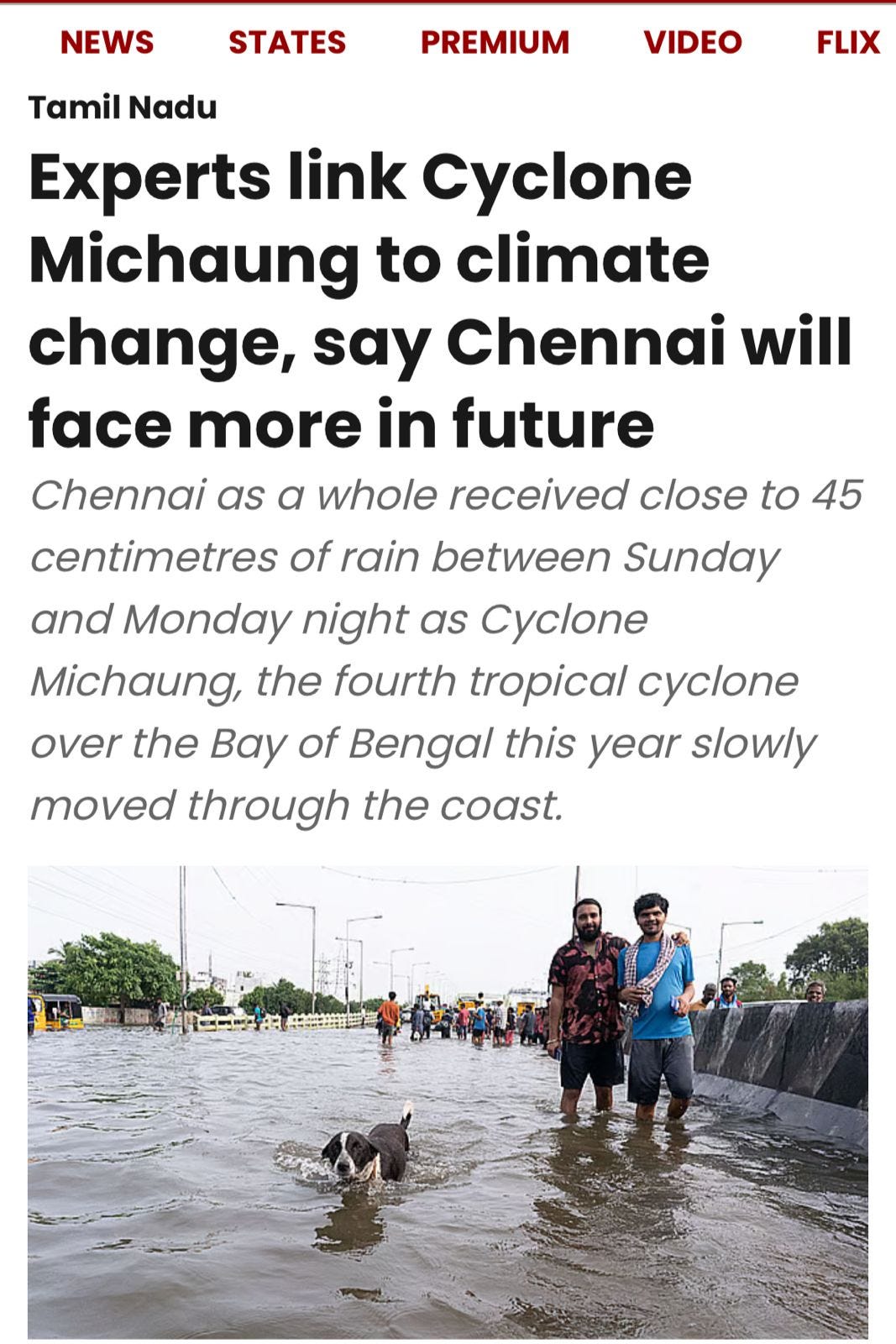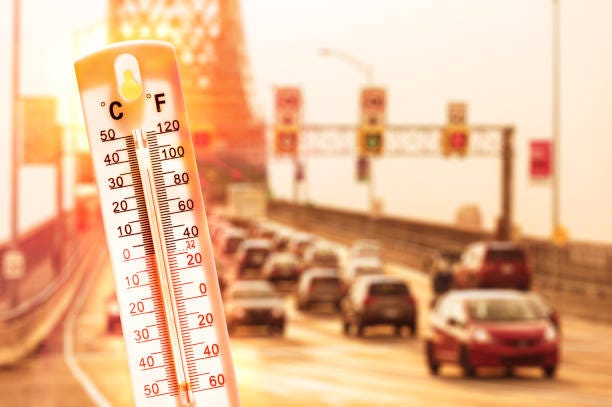From Delhi to Chennai - You don't need a heat wave to feel the burn every summer
A new study on heat and mortality shows that excess heat can affect mortality for even up to 6 days after exposure.
The world we live in is getting hotter. We don't need science and scientists to experience this truth. We feel the rising temperatures every summer in the sweat that we constantly wipe off our brows, in the increasing electricity bills as we struggle to sleep and finally in the abject fear we have in stepping out onto our roads on a hot afternoon.
We intuitively know that the environment around us is changing but this truth is even more jarring when numbers are attached to it.

By now, most of you would have seen that we have managed to break yet another record!
2023 has by far been the hottest year on this planet by a significant margin and is likely the world’s warmest in the last 100,000 years, according to the European Union’s climate agency.
But atmospheric temperature is just a part of this problem. Just in 2023 -
1. Antarctic sea ice hit an extreme low
2. Glaciers in North America and the Alps saw an extreme melt season
3. Sea surface temperature hit the highest recorded temperature
4. We breached the 1.5 degrees temperature warning
5. Heatwaves arrived earlier in India than considered normal.
6. And in Chennai, increased sea surface temperatures led to record rains in the form of Cyclone Michaung.
A significant fear in regard to global warming is that it would make our planet uninhabitable. And of all the problems it could cause, my biggest fear is the unbearable heat itself and I would be surprised if it is not yours as well.
This fear led me to develop a morbid interest in understanding how heat affects human mortality.
It was by chance that I came across this study - Excess Mortality Risk Due to Heat Stress in Different Climatic Zones of India
It tries to understand the vulnerability to heat stress in India using 42 years (1979−2020) of meteorological data for three cities - Delhi, Varanasi and Chennai. This is being done by studying all-cause nontrauma mortality data or deaths caused due to any disease, complication, or hazardous exposure, which have no sign of physical trauma on the body.
I feverishly read through it as soon as I got my hands on it. But when I finished, I realised I really didn't understand much of it at all. 👀👀
I was getting lost in abbreviations, formulae and terms I had to google. As a resident of a very hot Chennai and someone who wants to understand how heat will affect me, I didn't want to give up. I combed through the study several more times and spoke to experts to decode it so that you don't have to.
Here is the breakdown of what I learnt -
1. Why is this study important?
According to the study, heat is one of the leading natural causes of mortality in India. It contributes to 18.2% of deaths and heat related mortality has increased by 146% between 1967 and 2009.
Yes, the heat is literally trying to kill me. My summer irritation is justified. 😡
2. As global temperatures rise India is very vulnerable to heat related impacts due to its geographical position. (Well, duh)
3. Existing studies in this matter, only look at extreme temperatures while calculating heat risk and don't account for 'humidity, wind speed, and intensity of solar radiation on human health'. (Hello, past scientists, have you not visited Chennai or experienced humidity? We are drowning in our own sweat here!)
2. The study describes 5 climate zones - arid, semiarid, humid subtropical, tropical wet, tropical wet and dry.
Of this,
Chennai is Tropical Wet and Dry
Delhi is semi arid
Varanasi is humid subtropical
I think the reason is pretty evident and based on proximity to water bodies. But here is the curve ball. All these cities because of their climate, have different comfort class thresholds and what is a comfort class threshold you ask? Well, it is the temperature at which you can say, 'Okay, I am comfortable'. Hehe.
Here is the break up of the temperatures from the study -
Soo,
Sweltering - IHI > 90th percentile in the region
Very Hot - IHI - 75th to 90th percentile in the region
Hot - IHI - 50th to 75th in the region
Comfortable - IHI < 25th percentile in the region
For Chennai to actually be considered comfortable the temperature has to be below 23.8 degrees or as we call it, Chennai SNOW days. 😂
3. Even what is considered a Heatwave changes because of this. For humid subtropical, and tropical wet and dry climate zones the temperature has to be over 40 °C for 2 consecutive days to be considered a Heat wave. In a city like Chennai, even days with over 37 °C are considered heat wave days. 😭
4. Now that the parameters are set, lets look at the time periods they did this study for and the deaths recorded then -
Delhi - 2013 - 2017
Avg temp - 30.4 °C
Avg number of deaths - 181
Varanasi - 2009 - 2016
Avg temp - 30.9 °C
Avg number of deaths - 21
Chennai - 2004 - 2009
Avg temp - 30.4 °C
Avg number of deaths - 103
(All between 16th March to 15th July)
5. But while the above statistics may seem normal, check out the number of sweltering days vs comfortable days in the three cities.
Chennai had ZERO comfortable days and the MOST number of very hot days.
6. And to make it worse, the Relative Humidity in the city was found to be a huge stressor even on Non-Heatwave days.
On non-heatwave days the Relative humidity recorded was 51.8% (Delhi), 52.5% (Varanasi), and 72.3% (Chennai).
On Heatwave days actually the Relative humidity was only 32.2%, 42.5%, and 58.1% respectively.
So this would mean, in all cities and especially Chennai, we don't need a heatwave to feel heat stress during the summers.
A scientist once told me that when relative humidity is high, it feels like you are functioning in a steam bath. Your body if exposed to the humidity for too long, will find it difficult to cool off as warm moisture remains on your skin for longer. It can cause everything from dehydration and muscle cramps to a heat stroke.
7. So, it is not surprising that this paper found an increase in all cause nontrauma mortality in all three cities in this time period.
Chennai - 3.1% increase
Delhi - 3.2% increase
Varanasi - 6.8% increase.
But this doesn't mean that Chennai can in any manner relax. The highest effect was observed during sweltering days and for Chennai this meant 8% increase in mortality while for Delhi and and Varanasi this meant a 5.9% and 8.1% increase respectively.
What I found more worrying however, is this 'lag' effect that the paper talks about.
8. The paper examines the time-lag effect of the Heat on excess mortality.
It found that the effects of the heat could last for days after and was rather significant.
In Delhi, there was a 3 day lag effect.
In Varanasi, there was a 4 day lag effect.
In Chennai, there was a 6 day lag effect.
To put it crudely, this means that if a person in Chennai is exposed to heat stress today and is declared dead six days later, it still means that heat could still be a huge contributor to his/her death.
9. What makes this study even more important to consider is that exposure response doesn't begin at 40°C for Varanasi and Delhi or at 37°C for Chennai.
It started MUCH EARLIER.
In Delhi, the exposure response slope begins to curve more upward at around 33°C
Varanasi at 32.5 °C
And Chennai at 29.5 °C
This, according to the paper, shows the need for refinement of thresholds at the local scale because tolerance to heat stress very clearly changes based on geography.
10. Further, the paper (much to its credit) also did a gender specific analysis.
And like most climate related problems, the impact on women is more.
"The gender-specific analysis revealed a risk of 3.7−6.9% (per unit increase in IHI) increase in female mortality and 2.9−6.7% increase in male mortality in Delhi and Varanasi, respectively. In Chennai, the effect of per unit increase in IHI for males was not statistically significant, whereas for females, the mortality risk was 5.3% higher."
11. Age too plays a role with populations older than 64 years feeling a higher impact.
5.7% in Chennai
4.2% in Delhi
and 7.5% in Varanasi
12. So now that we know what the study says, let me draw out some final inferences I made from the paper.
Heat is a problem that is not being taken seriously enough especially in relation to mortality. There needs to be better recording of heat related deaths across the country in order to improve clarity and facilitate solution oriented action.
Excess Heat = More deaths
We need heat action plans that are at a city/district level. Even within a state, the effects of heat vary greatly from one area to another.
The assumption that we only need to worry about Heatwave days is clearly problematic. The mortality risk on non heatwave days is also significant.
The lag effect of heat stress was new information to me. This could really affect how we attribute mortality to heat up to 6 days or more after the exposure.
Relative Humidity must be considered when trying to assess heat stress, temperature alone is not enough.
We desperately need early warning systems which vary based on the climatic zone to alert people of the dangers of heat exposure at various times of the year, especially summer.
Another summer and more heat related issues is fast approaching and with so much information in our hands, it is time to act and act FAST.
Special thanks to Mr.Abhiyant Tiwari, an expert on Heat who helped me make sense of this study!
















